-
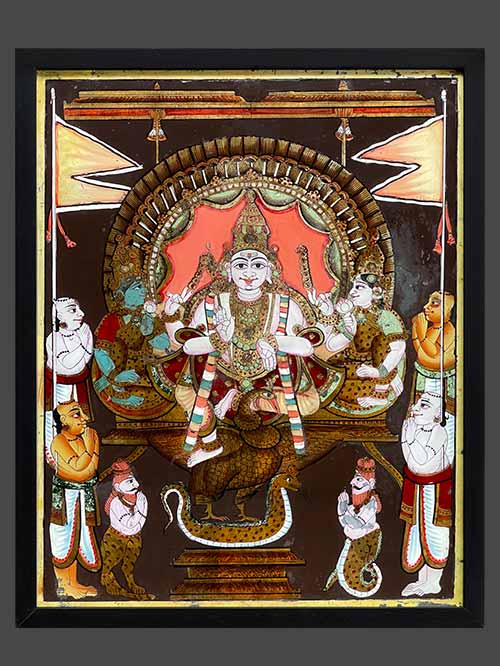
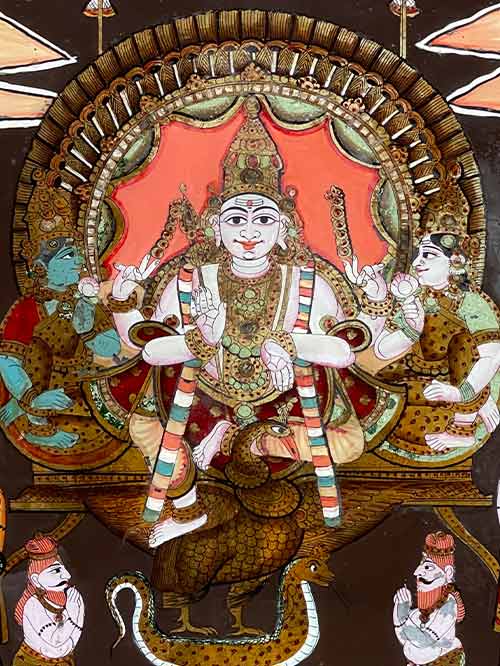
Tanjore (South India)
reverse painting on glass
Kartikeya (also known as Subrahmanyam, Murugan or Skanda) sits on a throne held up by his conveyance, the peacock. His consorts, the fair Devasena on his left and the blue-complexioned Valli on his right, are seated by his side. The realistically rendered tail of the peacock frames the trio and doubles as a ritual prabhavali. The peacock stands majestically with its talons firmly planted on a cobra. Set against a brown background, flags define the sides of the painting where four Brahmin devotees pay homage to the divine group along with the sages Patanjali on the right and Vyaghrapada on the left.
Reverse glass paintings were introduced into India the late 18th century from China by way of the China Trade. Indian artists adopted the technique of reverse glass painting partly on account of its novelty and also because it was a relatively inexpensive medium which could produce rich effects. The technique proved extremely popular and soon spread through western and southern India and even to former provincial Mughal capitals of Oudh, Murshidabad.
In Tanjore – a small state with an old art tradition- a distinctive school of glass painting developed in the early 19th century and continued for more than a hundred years. The style was essential Indian – it tended to repeat patterns of regional painting: images of deities, portraits and themes form the ancient myths, secular themes such as portraits of kings or nobles, courtesans and musicians. The colour was rich and the style bold and defiant. The subjects were clearly presented with a certain opulence and glamour.
Painting Size (cms): 50(H) x 40(W)
Painting Size (inches): 19.75(H) x 15.75(W)
Framed Size (cms): 54(H) x 44(W) x 4(D)
Framed Size (inches): 21.5(H) x 17.5(W) x 1.5(D)
-

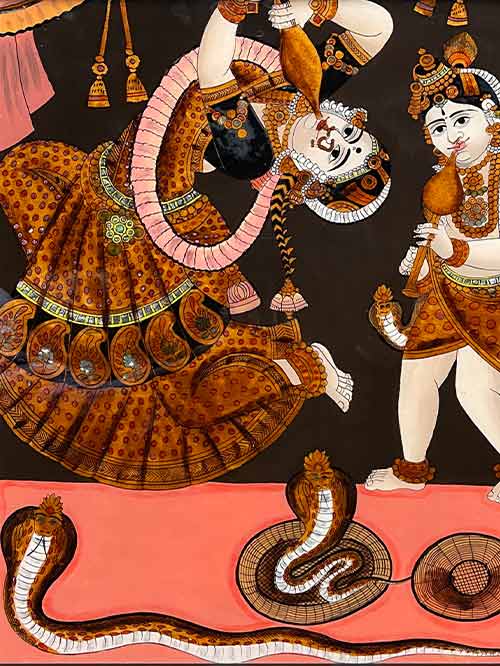
Tanjore (South India)
reverse painting on glass
A charming reverse glass painting depicting a Krishna and Yashoda as snake charmers each hypnotising a cobra with the melodic sounds of their fluted instruments called pungis. The adolescent Krishna is bejewelled and splendidly clad in a lower garment with a hip-hugging sash and a garland of flowers around his neck. His foster-mother Yashoda who is also gorgeously robed and jewelled contorts around to befuddle the snakes.
Reverse glass paintings were introduced into India the late 18th century from China by way of the China Trade. Indian artists adopted the technique of reverse glass painting partly on account of its novelty and also because it was a relatively inexpensive medium which could produce rich effects. The technique proved extremely popular and soon spread through western and southern India and even to former provincial Mughal capitals of Oudh, Murshidabad.
In Tanjore – a small state with an old art tradition- a distinctive school of glass painting developed in the early 19th century and continued for more than a hundred years. The style was essential Indian – it tended to repeat patterns of regional painting: images of deities, portraits and themes form the ancient myths, secular themes such as portraits of kings or nobles, courtesans and musicians. The colour was rich and the style bold and defiant. The subjects were clearly presented with a certain opulence and glamour.
Painting Size(cms): 47 (H) x 43.2 (W)
Painting Size(inch): 18.5 (H) x 17 (W)
Framed Size (cms): 49.5(H) x 46(W)
Framed Size (inches): 19.5(H) x 18(W)
-
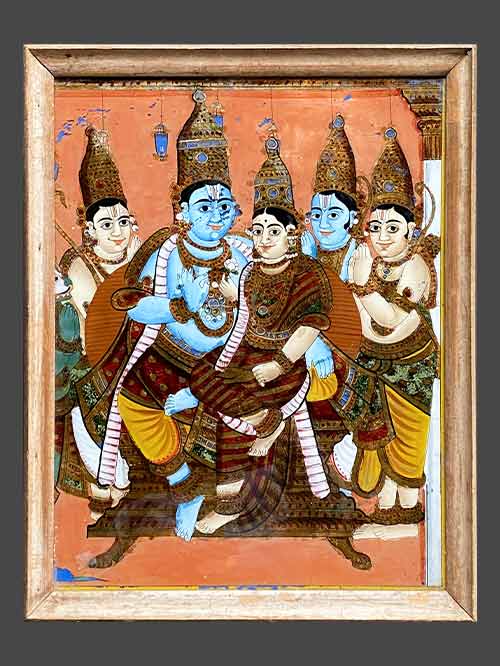
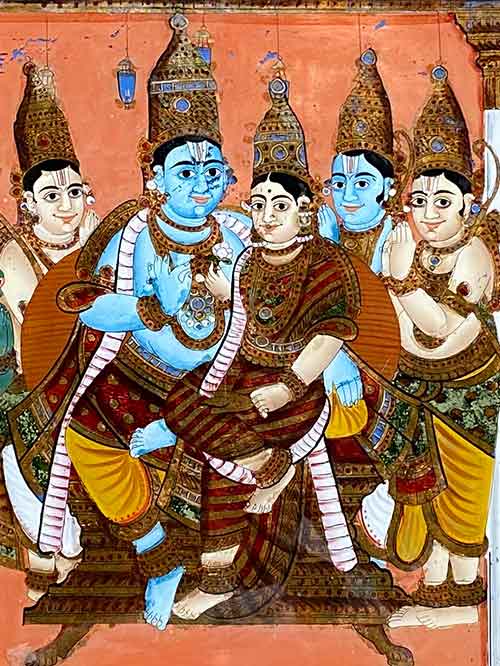
Tanjore (South India)
reverse painting on glass
The central group consists of Rama seated in lalitasana on a gilded throne with Sita on his lap. Lakshmana stands immediately behind him to the left; a blue-complexioned Bharata and Shatrugna stand behind Sita on the right. Rama, the hero of the Hindu epic Ramayana, was a king of Ayodhya and is regarded as an ideal ruler and a paragon of virtue. He is considered an avatar of Lord Vishnu. Rama’s journey portrays his unwavering devotion to his wife Sita and his ultimate triumph over the demon king Ravana.
Reverse glass paintings were introduced into India the late 18th century from China by way of the China Trade. Indian artists adopted the technique of reverse glass painting partly on account of its novelty and also because it was a relatively inexpensive medium which could produce rich effects. The technique proved extremely popular and soon spread through western and southern India and even to former provincial Mughal capitals of Oudh, Murshidabad.
In Tanjore – a small state with an old art tradition- a distinctive school of glass painting developed in the early 19th century and continued for more than a hundred years. The style was essential Indian – it tended to repeat patterns of regional painting: images of deities, portraits and themes form the ancient myths, secular themes such as portraits of kings or nobles, courtesans and musicians. The colour was rich and the style bold and defiant. The subjects were clearly presented with a certain opulence and glamour.
Framed Size (cms): 48.25(H) x 38(W)
Framed Size (inches): 19(H) x 15(W)
-
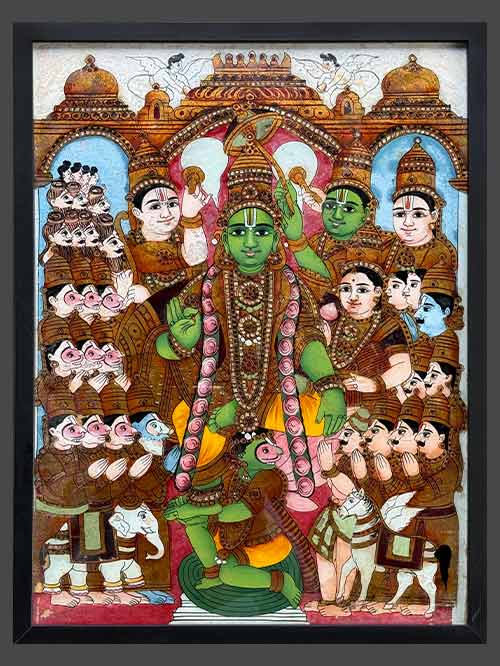
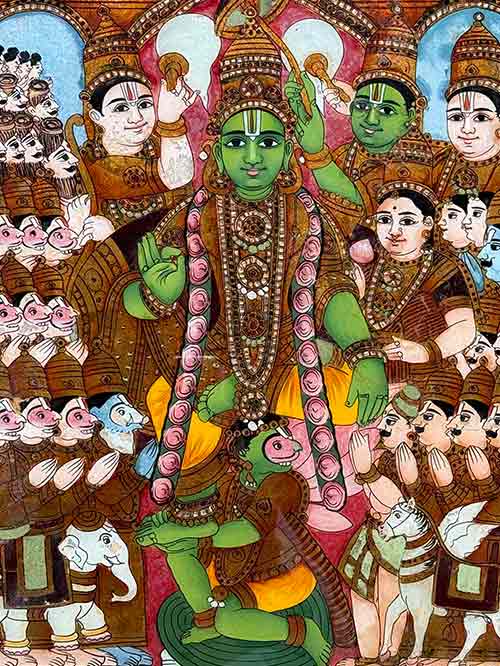
Tanjore (South India)
reverse painting on glass
Rama’s coronation, Ramapattabhisheka, is one of the most popular themes of South Indian painting. The central group consists of Rama seated in lalitasana on the throne with Sita to his left; Lakshmana carrying a chamara (fly whisk) standing immediately behind him; a green-complexioned Bharata carrying a parasol standing behind Sita; Shatrugna with a fly whisk to Bharata’s left and finally, in the foreground, Hanuman lovingly supporting Rama’s right foot. On either side are groups of attendees. The group on the left consist of ascetics, the monkeys and Jambavan — here recognisable by his blue snout. On the right are a number of courtly figures. Among them should be Vibhishana, the new king of Lanka, who helped Rama in defeating Ravana, but not readily recognisable here.
Reverse glass paintings were introduced into India the late 18th century from China by way of the China Trade. Indian artists adopted the technique of reverse glass painting partly on account of its novelty and also because it was a relatively inexpensive medium which could produce rich effects. The technique proved extremely popular and soon spread through western and southern India and even to former provincial Mughal capitals of Oudh, Murshidabad.
In Tanjore – a small state with an old art tradition- a distinctive school of glass painting developed in the early 19th century and continued for more than a hundred years. The style was essential Indian – it tended to repeat patterns of regional painting: images of deities, portraits and themes form the ancient myths, secular themes such as portraits of kings or nobles, courtesans and musicians. The colour was rich and the style bold and defiant. The subjects were clearly presented with a certain opulence and glamour.
Framed Size (cms): 64(H) x 49(W)
Framed Size (inches): 25.25(H) x 19.25(W)
-
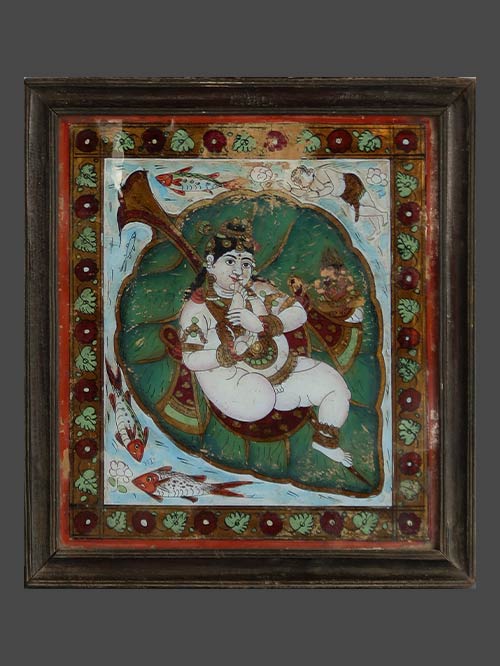
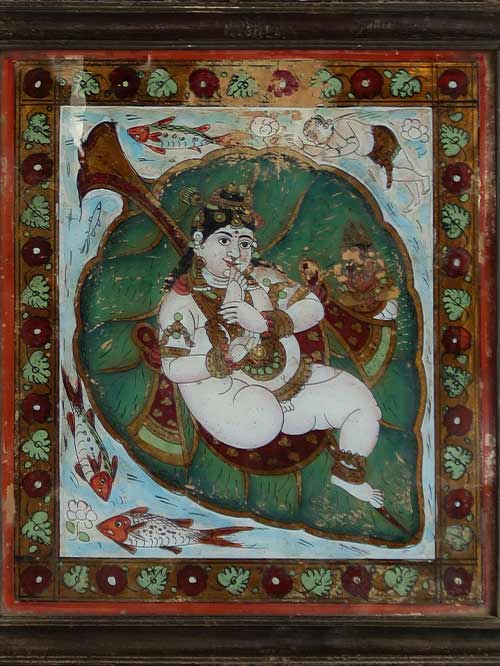
Tanjore (South India)
reverse painting on glass
Krishna as a child lies on a giant banyan leaf content, innocent, with a hint of amusement on his face. Naked but for his jewellery and a draped angavastra, he is depicted sucking his raised toe. As always, he is shown as a chubby child. The leaf he rests on is encircled by a school of fish, swimming amidst the primordial waters. Depicted on the top right is the sage Markandeya reaching out for the safety of the banyan leaf. A diminutive Brahma hovers above Krishna’s left foot. A border of leaves and roundels frames the scene.
The story of Krishna as Vatapatrasayi, or the Lord of the Banyan Leaf, occurs during the end of the world when the sage Markandeya sees the destruction caused by the great flood. In the midst of the chaos, he sees a small child floating on a banyan leaf, sucking his raised toe. Markandeya is drawn into the child’s body where he discovers the entire world, with all its realms, contained within the child who is oblivious to the disaster happening outside. The sage then realises that the child is a god who has taken the world into himself before recreating the universe.
Reverse glass paintings were introduced into India the late 18th century from China by way of the China Trade. Indian artists adopted the technique of reverse glass painting partly on account of its novelty and also because it was a relatively inexpensive medium which could produce rich effects. The technique proved extremely popular and soon spread through western and southern India and even to former provincial Mughal capitals of Oudh, Murshidabad. In Tanjore a distinctive school of glass painting developed, with a rich colour and bold and defiant style. The subjects were clearly presented with a certain opulence and glamour.
Framed Size (cms): 46.5(H) x 41.5(W)
Framed Size (inches): 18.5(H) x 16.5(W)
Painting Size (cms):39.5(H) x 31.5(W)
Painting Size (inches):15.5(H) x 12.5(W)
-
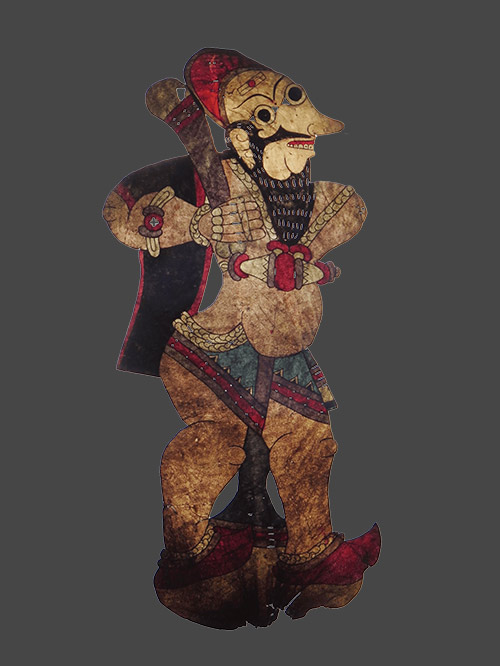
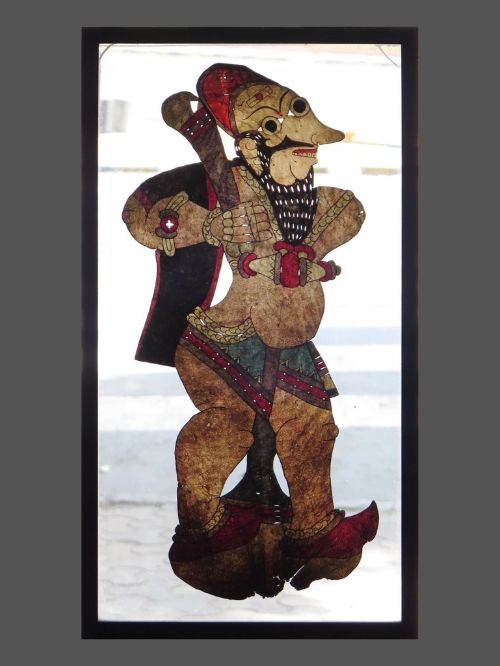
Karnataka (South India)
Framed Leather Shadow Puppet
The art of puppetry, called Togalugombayeta in Karnataka, involves acting out well known epic episodes using puppets made of flat leather pieces operated by a stick. The perforated leather is illuminated from behind, making this a form of shadow theatre. It is thought that the puppets were invented to avoid having gods and goddesses – who feature prominently in Indian epics like the Ramayana and Mahabharata – depicted by humans.
Size(cms): 69 (H) x 37 (L)
Size(inches): 27.2 (H) x 14.6 (L)
-
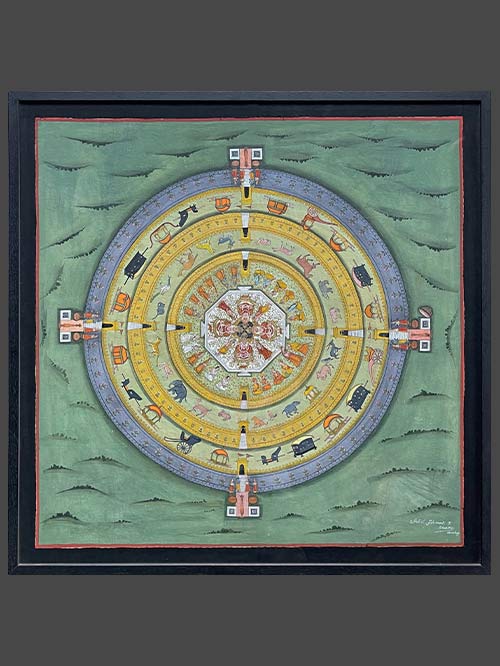
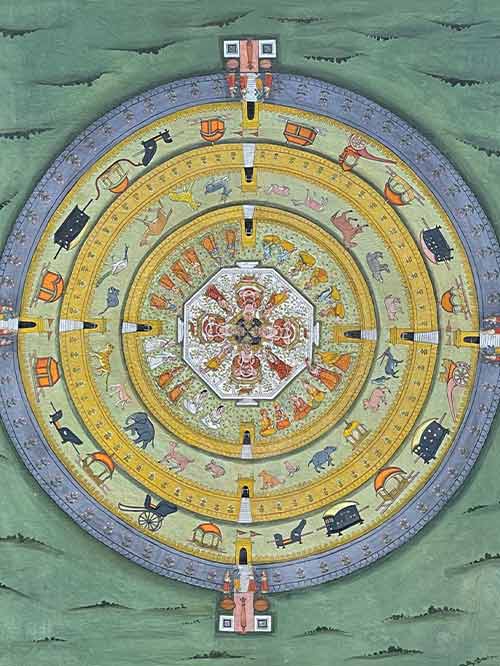
Maharashtra
Signed by the artist ‘Hemant T., Bombay’
Opaque watercolour on paper
Samavasarana symbolises the Jina’s deliverance of his first teachings after attaining enlightenment during which he is said to be miraculously visible simultaneously in every direction. This particular example provides an unusual presentation of the theme.
The entire enclosure is placed on a vast plain painted in green and covered with tufts of vegetation. The outermost enclosure, said to be made of silver, is filled with numerous vehicles, including European carriages and coaches, carts, sedan chairs, and various kinds of palanquins. Presumably they are conveyances of the dignitaries who have come to hear the sermon. In the second enclosure, made of gold, a wide variety of animals is represented. Even though they are not paired, the mix clearly indicates the tranquil atmosphere of the place. The third enclosure, made of gems, is occupied by divinities, monks, and lay personages. Curiously, each quarter segment includes six figures. All of the women stand, while the men are shown seated. On the octagonal crystal pedestal in the center are four identical Jina images facing in the cardinal directions. The idea is to demonstrate the Jinas simultaneous visibility from all sides.
Framed Size (cms): 94(H) x 94(W)
Framed Size (inches): 37(H) x 37(W)
-

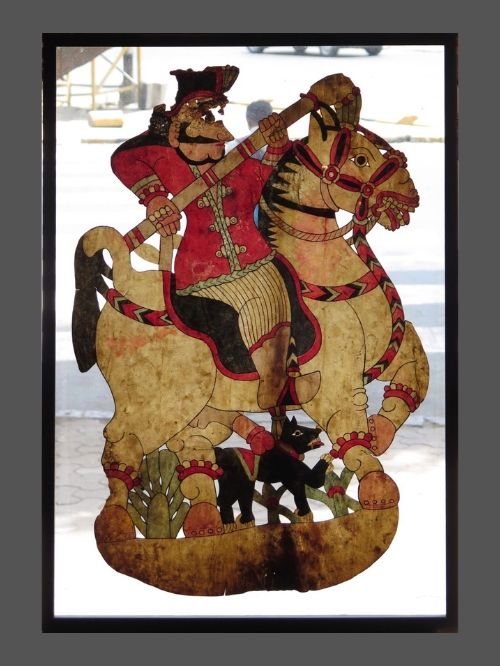
Karnataka (South India)
Framed Leather Shadow Puppet
The art of puppetry, called Togalugombayeta in Karnataka, involves acting out well known epic episodes using puppets made of flat leather pieces operated by a stick. The perforated leather is illuminated from behind, making this a form of shadow theatre. It is thought that the puppets were invented to avoid having gods and goddesses – who feature prominently in Indian epics like the Ramayana and Mahabharata – depicted by humans.
Size(cms): 91 (H) x 62 (L)
Size(inches): 35.8 (H) x 13.4 (L)
-
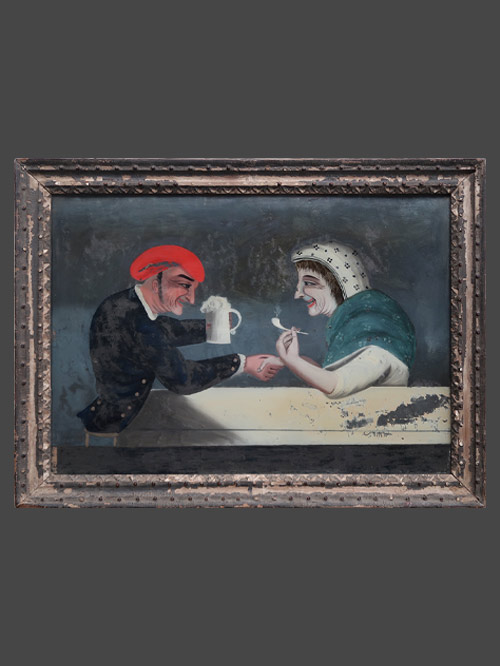
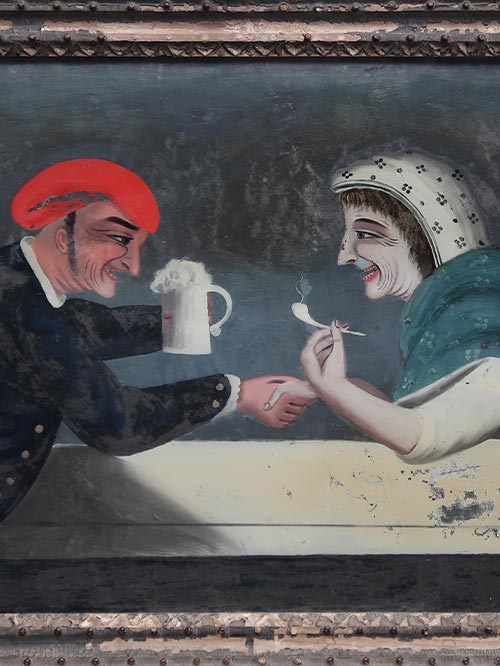
Western India
reverse painting on glass by a Chinese Artist
The love for the exotic is amply demonstrated by this copy of a Dutch genre painting or engraving. An aged couple sit at the table; their curved shoulders and wrinkled faces unmercifully rendered. The man, in a red cap and dark jacket with metal buttons, carries in one hand a tankard filled with beer whose head is almost running over its rim. He warmly shakes the hand of the woman, who holds a pipe in her left hand. Her head is covered by a light coloured cloth and her shoulders are swathed in an indigo shawl, both executed in tie and dye technique. These items, imported from India, were extremely fashionable in eighteenth and nineteenth century Europe. A shaft of light falls on the table and on the couple, setting off the man’s cap and the woman’s head cloth and shawl on an otherwise grey background.
Reverse glass paintings were introduced into India the late 18th century from China by way of the China Trade. Indian artists adopted the technique of reverse glass painting partly on account of its novelty and also because it was a relatively inexpensive medium which could produce rich effects. The technique proved extremely popular and soon spread through western and southern India and even to former provincial Mughal capitals of Oudh, Murshidabad.
What is also significant is that there were some Chinese painters at work in India as well. One is known to have been at the court of Tipu Sultan and a large number of his paintings are in the collection of the Jagmohan Palace Art Gallery at Mysore. A lively market for reverse glass paintings, mainly depicting Hindu deities and portraiture by Chinese artists likely flourished, particularly on the west coast in places like Surat and Cambay.
Size Framed (cms): 42 (H) x 57 (L)
Size Framed (inch): 16.5 (H) x 22.4 (L)
Size Painting (cms): 34 (H) x 49 (L)
Size Painting (inch): 13.4 (H) x 19.3 (L)
-

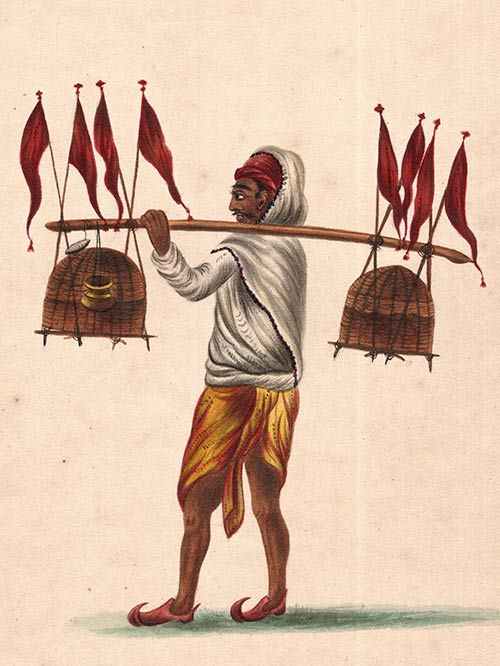
Patna (Eastern India)
Opaque watercolour on European paper
This captivating Company Painting depicts a man carrying two baskets suspended on a pole, with red flags attached at either end. A brass lota peeks out from one of the baskets. The water carrier is on his way back from Benares carrying the holy water from the sacred river
Under the Mughals Patna had never been a great artistic centre and although its Muhammadan governors had employed Mughal artists, there is no evidence that any strongly marked local style had developed. Yet Patna, like Murshidabad, was undergoing a social revolution and various circumstances in the later eighteenth century were to make it a centre of Indian-British painting. As a result of its increasing prosperity, a number of artists of the Kayasth caste were attracted to Patna from Murshidabad. One of these was a certain Sewak Ram, who had migrated there by I790. He began to produce sets of occupations as well as large paintings of ceremonies and festivals. One such set, now in the India Office Library, was purchased by Lord Minto, while a painting from a similar set in the Indian Department of the Victoria and Albert Museum was acquired by Lord Amherst when he was Governor-General (August 1823 to March 1828). British taste in the early nineteenth century shows itself in both subjects and colour range – sepia wash enlivened with touches of brighter colour – adopted by the Patna artists.
Painting Size (cms): 23(H) x 18.5(W)
Painting Size (inches): 9(H) x 7.5(W)
-
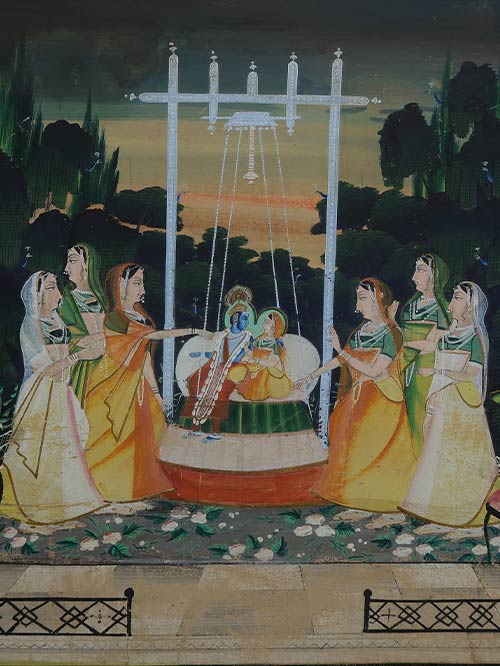
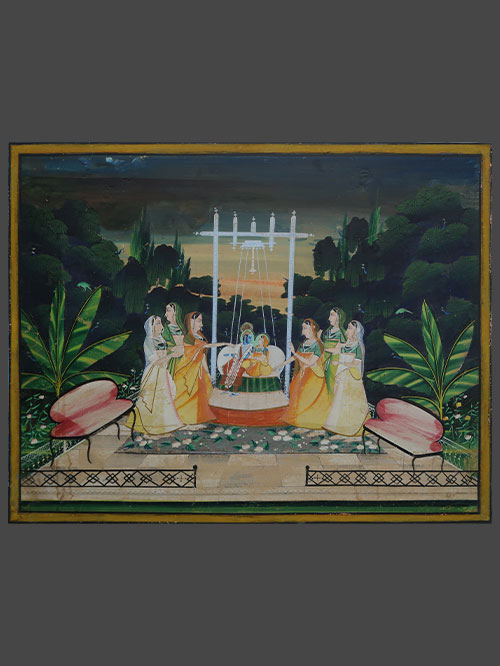
Nathdwara (Rajasthan)
opaque watercolour and gold on paper
Krishna and Radha sit resting against a large white bolster on an ornate silver swing. Underfoot is a floral decorated carpet on a chequered marble floor with iron balustrades. Six female attendants flank the nimbate couple whose gazes are firmly fixed on each other. In the foreground are a pair of European style pink settees while in the distance an orange hued sky indicates the setting sun. Dense clusters of trees and foliage sprinkled with parrots and peacocks envelope the central scene.
Such large and dramatic scenes were painted by Nathdwara artists who produced these images for devotees who visited the great Krishna temple at Nathdwara in Rajasthan. Founded in the 17th century, this temple has attracted an enormous following even to this day, in turn ensuring a continuing tradition of devotional images. The extravagant size and conception of these paintings remind one of the constant importance of religious images in India, not only as ritual objects but also items for pilgrims to acquire and bring home from the great Hindu shrines.
Towards the end of the nineteenth century and early twentieth century Nathdwara artists were exposed for the first time to European art prints whose influence can be seen in the paintings of this period.
Size Painting (cms): 44.5 (H) x 57 (W)
Size Painting (inch): 17.5 (H) x 22.4 (L)
-
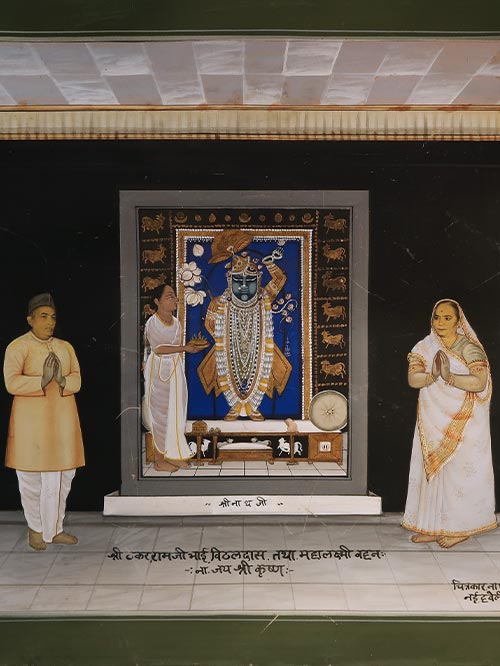
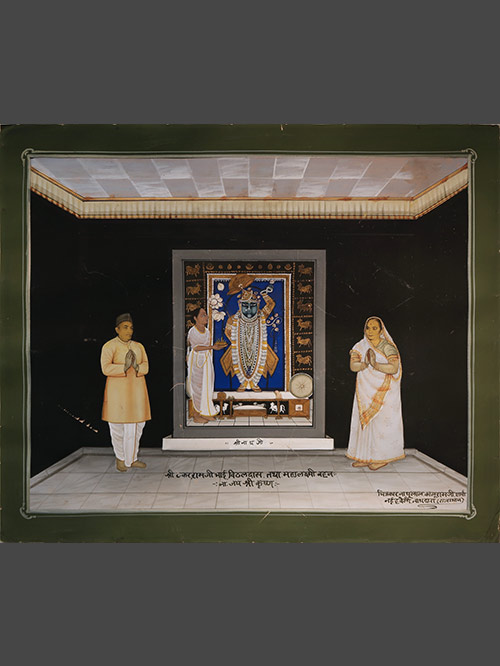
Nathdwara (Rajasthan)
Opaque watercolour, gold and gelatin silver print on paper
Inscribed on recto ‘Nathulal Kaluramji Sharma, Nathdwara’
In Pushti Marga terminology, to perform a manoratha is to offer a seva ( ritualistic service) to the deity in fulfilment of a long cherished inner yearning to serve him in a special way on a particular day. Only a few select Goswamis, direct descendants of Vallbhacharya, are given this privilege and every Goswami longs to perform a manoratha at least once in a lifetime. A wealthy devotee can also perform a manoratha on an important day of his life or in the fulfilment of a vow. This is done by contributing towards the expenses of a particular darshana ( formal viewing of a deity) or by paying for the seva of an entire day. To commemorate this event, devotees usually commission a painting showing them on both sides of Srinathji outside the threshed of the sanctum. In the present painting actual photographs of the donors faces are incorporated into the painting. This served as a visual record of their worship before the famed icon.
Sri-Nathji ( The Lord of Shri, Goddess of Wealth) enshrined at Nathdwara is the most important svarupa (own form) in the Pushti Marga, and represents Krishna at the age of seven. Sri-Nathji is Krishna incarnate, the tutelary deity of the Vallabhacharya whose swarupa or image is enshrined at Nathdwara.
Painting Size (cms): 50.5 (H) x 60.5 (L)
Painting Size (inch): 19.9 (H) x 23.8 (L)
-
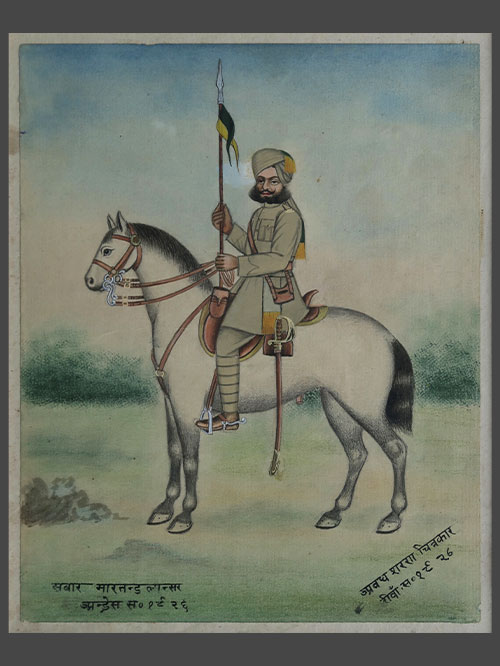
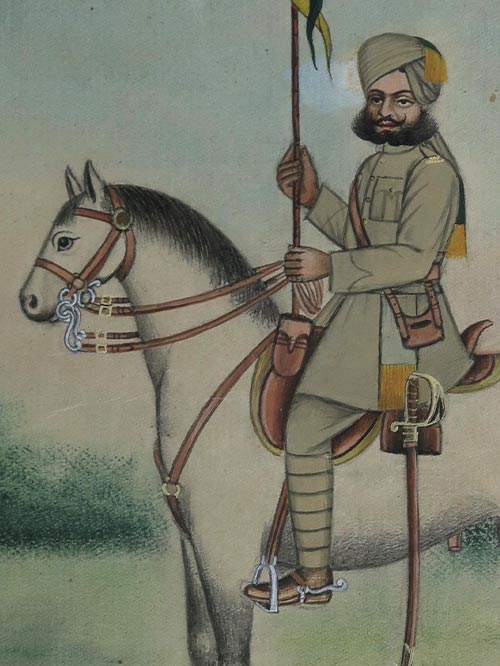
Rewa (Central India)
pigments on paper
Company Painting, Signed by the artist Avadh Sharan
A charming Company painting of a lancer captioned, “Rider Maartand Lancer.” Originally bound in an album. Lancers were a type of cavalryman who fought with lances, a pole weapon similar to a spike or spear. The first armoured troops in India were formed in 1914. In 1921, the Indian Army cavalry regiments were reorganised, and consolidated into twenty-one regiments. During this period, the Indian army was a separate organisation to the British Army. The main task of the Indian Army was to police the Indian Empire. During the first and second world wars, Indian troops served with distinction in France in 1940, Egypt, Libya, the Sudan, Abyssinia, Syria, Persia, Iraq, Malaya and Burma.
‘Company’ is a designation given to works by Indian artists painted in a mixed Indo-European style for the various East India companies. The foundation of this Indo-European style can be traced to the establishment of the first Portuguese trading posts. The British only counted as patrons in the 1760s following Clive’s victory at Plassey in 1757 . Patronage by the British in effect followed the flag. Princely states never directly under British control produced little company art and important centres like Delhi and Agra only became so after the British stabilised the reason in the early 1800s. Photography gradually replaced the genre in the 1840s but the style lingered on until the late nineteenth century. Barring minor regional variations, Company Style took the same form in all the centres. The favourite subjects were trades, costumes, crafts and festivals. Also popular were topographical pictures of contemporary India and exotic flora and fauna.
Painting Size (cms): 22 (H) x 18 (W)
Painting Size (inch): 8.5 (H) x 7 (L)
Framed Size (cms): 36.5 (H) x 32 (W)
Framed Size (inch): 14.5 (H) x 12.5 (L)
-
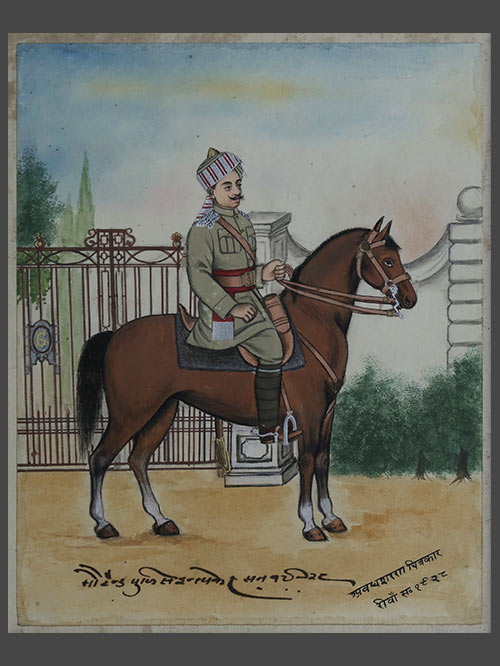

Rewa (Central India)
pigments on paper
Company Painting, Signed by the artist Avadh Sharan
A charming Company painting of a mounted Police Officer from Rewa in Central India. Unusually the painting is signed by the artist Avadh Sharan and also dated 1928. Originally bound in an album.
‘Company’ is a designation given to works by Indian artists painted in a mixed Indo-European style for the various East India companies. The foundation of this Indo-European style can be traced to the establishment of the first Portuguese trading posts. The British only counted as patrons in the 1760s following Clive’s victory at Plassey in 1757 . Patronage by the British in effect followed the flag. Princely states never directly under British control produced little company art and important centres like Delhi and Agra only became so after the British stabilised the reason in the early 1800s. Photography gradually replaced the genre in the 1840s but the style lingered on until the late nineteenth century. Barring minor regional variations, Company Style took the same form in all the centres. The favourite subjects were trades, costumes, crafts and festivals. Also popular were topographical pictures of contemporary India and exotic flora and fauna.
Painting Size (cms): 22 (H) x 18 (W)
Painting Size (inch): 8.5 (H) x 7 (L)
Framed Size (cms): 36.5 (H) x 32 (W)
Framed Size (inch): 14.5 (H) x 12.5 (L)
-
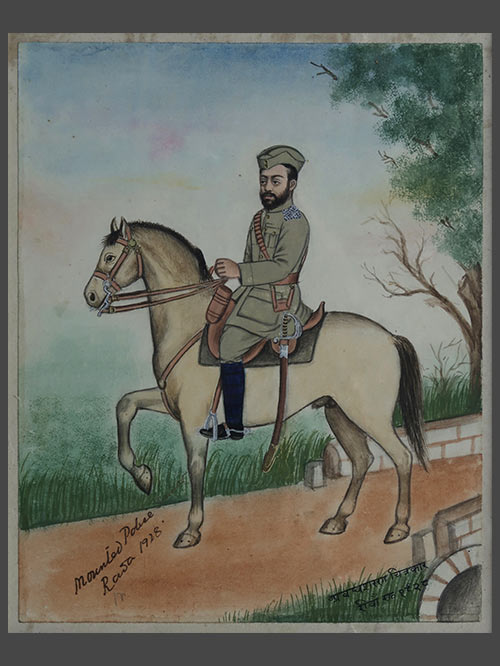
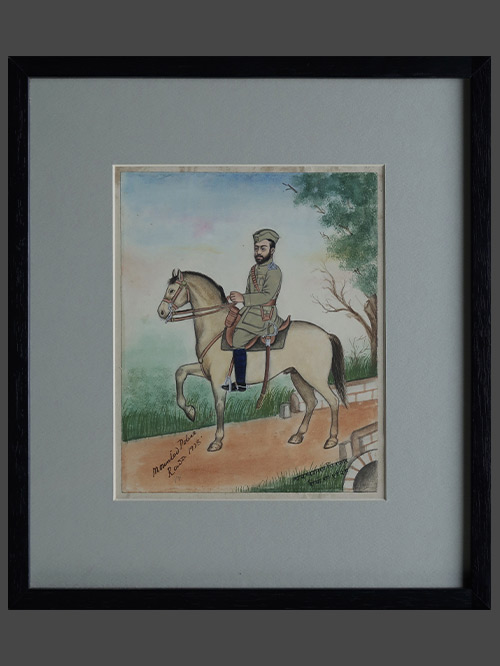
Rewa (Central India)
pigments on paper
Company Painting, Signed by the artist Avadh Sharan
A charming Company painting of a policeman captioned, “Mounted Police, Rewa.” Originally bound in an album. The Indian Police Services was part of the uniform system of police administration in British Raj, as established by Government of India Act 1858, Police Act of 1861. It was motivated by the danger experienced by the British during the 1857 rebellion. During 1920s the Imperial Indian police had 310,000 police in their contingent. Its members policed more than 300 million people in India, Pakistan, Bangladesh and Burma (then comprising British Raj). The police held a multiplicity of functions. As an agency of state coercion and intelligence gathering, the police were vital to Britain’s attempts to hold onto power in India. By the mid-1940s the erosion of police loyalty towards the British was an important index of Britain’s waning power.
‘Company’ is a designation given to works by Indian artists painted in a mixed Indo-European style for the various East India companies. The foundation of this Indo-European style can be traced to the establishment of the first Portuguese trading posts. The British only counted as patrons in the 1760s following Clive’s victory at Plassey in 1757 . Patronage by the British in effect followed the flag. Princely states never directly under British control produced little company art and important centres like Delhi and Agra only became so after the British stabilised the reason in the early 1800s. Photography gradually replaced the genre in the 1840s but the style lingered on until the late nineteenth century. Barring minor regional variations, Company Style took the same form in all the centres. The favourite subjects were trades, costumes, crafts and festivals. Also popular were topographical pictures of contemporary India and exotic flora and fauna.
Painting Size (cms): 22 (H) x 18 (W)
Painting Size (inch): 8.5 (H) x 7 (L)
Framed Size (cms): 36.5 (H) x 32 (W)
Framed Size (inch): 14.5 (H) x 12.5 (L)
-

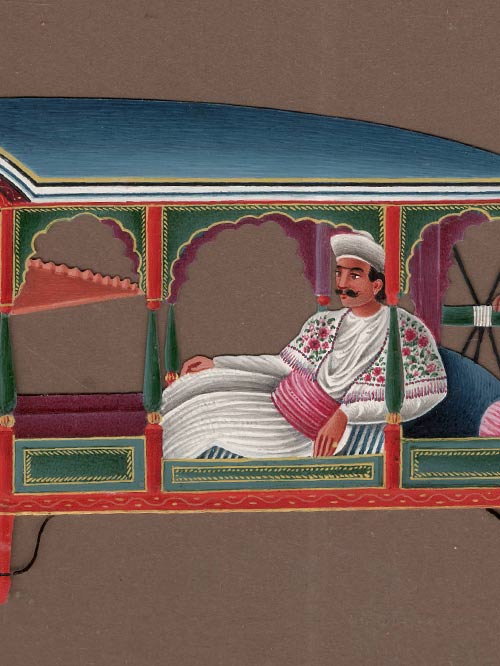
Patna (Eastern India)
Pigments on Mica
A charming and finely painted pair of mica paintings of palanquins carried by colourfully dressed palanquin bearers and a partially obscured parasol bearer. The closed palanquin affording only a glimpse of its seated patron, the open palanquin occupied by an elegantly dressed gentleman reclining against a large bolster wearing a floral patterned shawl.
Under the Mughals, Patna had never been a great artistic centre and although its Muhammadan governors had employed Mughal artists, there is no evidence that any strongly marked local style had developed. Yet Patna, like Murshidabad, was undergoing a social revolution and various circumstances in the later eighteenth century were to make it a centre of Indian-British painting. As a result of its increasing prosperity, a number of artists of the Kayasth caste were attracted to Patna from Murshidabad. One of these was a certain Sewak Ram, who had migrated there by 1790. He began to produce sets of occupations as well as large paintings of ceremonies and festivals. One such set, now in the India Office Library, was purchased by Lord Minto, while a painting from a similar set in the Indian Department of the Victoria and Albert Museum was acquired by Lord Amherst when he was Governor-General (August 1823 to March 1828). British taste in the early nineteenth century shows itself in both subjects and colour range – sepia wash enlivened with touches of brighter colour – adopted by the Patna artists.
Individual Sizes (cms): 11.5(H) x 18(Diam)
Individual Size (inches): 4.5(H) x 7(Diam)

































